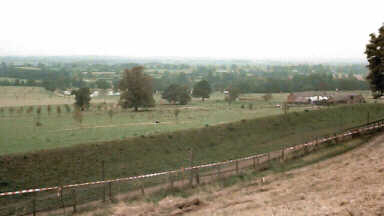Carden Park, Cheshire
Carden Park lies about 13 km (8 miles) to the south of Chester, in the western Cheshire lowlands. William Leche created it towards the end of the eighteenth century, with the late sixteenth- or early seventeenth-century Carden Hall at its focus. The land rises gently from Carden Brook, which forms its western edge, towards the spine road of the park, after which it rises more sharply. It culminates in a series of west-facing sandstone outcrops.
The prehistoric site was discovered in 1985, when a small collection of flints was found in the opening of a rabbit burrow, but there was no opportunity to investigate it until 1996. In this year, a joint project between Chester Archaeology (represented by Keith Matthews) and the University of Liverpool (represented by Anthony Sinclair) began investigating the area where these lithics had been discovered.
The site had lain in derelict parkland for many years, but the construction of a golf course in the early 1990s gave us a reason to look at it in more detail. We knew that it was part of a multi-period landscape, thanks to an audit done by Dr David Higgins (then of the University of Liverpool) in 1991. He recognised the importance of the prehistoric occupation of the cave but also pointed out the well preserved eighteenth-century landscape in which it was set. This was part of the park built by William Leche, the landowner and resident at Carden Hall, at the foot of the slope.
 The Hall burned down in 1912, but
prints, photographs and descriptions have survived. These show a
highly decorated timber-framed building on sandstone foundations.
Since the fire in 1912, only these footings, together with a
brick wine cellar and a small sandstone cellar have survived on
the site. The Park has been modified in recent years by the
construction of two golf courses and a driving range. Even so,
the former lodges, an icehouse, the former stables (now known as
Carden Hall Farm), a ha-ha and various landscape features are
still prominent.
The Hall burned down in 1912, but
prints, photographs and descriptions have survived. These show a
highly decorated timber-framed building on sandstone foundations.
Since the fire in 1912, only these footings, together with a
brick wine cellar and a small sandstone cellar have survived on
the site. The Park has been modified in recent years by the
construction of two golf courses and a driving range. Even so,
the former lodges, an icehouse, the former stables (now known as
Carden Hall Farm), a ha-ha and various landscape features are
still prominent.
The pieces of chert discovered in 1985 were identified as including some blades and core-trimming flakes of later Mesolithic type. The most interesting aspect of the discovery, though, was that they came from a mound of soil in front of a rock overhang, modified to form a small cave. It was known that a hermit, John Harris, had occupied the cave between 1744 and c 1765, but he can hardly have been responsible for the chert tools. Between 1991 and 1995 almost a hundred pieces of chert and flint were recovered from the eroding front edge of the mound of soil. The current project began in 1996 and was designed to find out more about this early occupation. As the work has progressed, it has come to include aspects of the historic landscape, the Pleasure Gardens, unexpected Bronze Age activity and much, much more. This site can only give a very superficial overview of the history of one Cheshire’s most beautiful and fascinating spots.